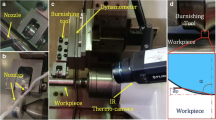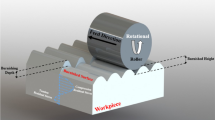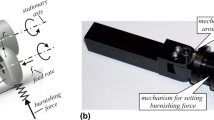Abstract
Highly stressed components of modern aircraft engines, like fan and compressor blades, have to satisfy stringent requirements regarding durability and reliability. The induction of compressive residual stresses and strain hardening in the surface layer of these components has proven as a very promising method to significantly increase their fatigue resistance. The required surface layer properties can be achieved by the roller burnishing process, which is characterised by high and deeply reaching compressive residual stresses, high strain hardening and excellent surface quality. In order to achieve a defined state of the surface layer, the determination of optimal process parameters for a given task still requires an elaborate experimental set-up and subsequent time-consuming and cost-extensive measurements. The development of well funded process knowledge about the correlation of the process parameters, the processed geometry and the surface layer state is the subject of this article.













Similar content being viewed by others
References
Achmus C (1999) Messung Und Berechnung Des Randschichtzustands Komplexer Bauteile Nach Dem Festwalzen, Phd-Thesis, Tu-Braunschweig
Berstein G, Fuchsbauer G (1982) Festwalzen und Schwingfestigkeit. Werkstofftechnik 13:103–109
Gibmeier J, Nobre JP, Scholtes B (2004) Residual stress determination by the hole drilling method in the case of highly stressed surface layers. Mater Sci Res Int 10(1):21–25
Hessert R, Bamberg J, Satzger W, Taxer T (2008) Ultrasonic impact treatment for surface hardening of the aero-engine material IN718. In: Proceeding of the 10th international conference on shot peening ICSP. pp 410-415, Tokyo, Japan
Jung U (1996) FEM Simulation und experimentelle Optimierung des Festwalzens bauteilähnlicher Proben unterschiedlicher Größen, PhD-Thesis, TU Darmstadt
Kelsey RA (1956) Measuring non-uniform residual stresses by the hole drilling method. Proc Soc Exp Stress Anal 14:181–194
Klocke F, Bäcker V, Wegner H, Timmer A (2009) Innovative FE-analysis of the roller burnishing process for different geometries In: X international conference on computational plasticity fundamentals and applications, Barcelona, Spain
Mader S (2007) Festwalzen von Fan- und Verdichterschaufeln, PhD-Thesis, RWTH Aachen
Niku-Lari A, Lu J, Flavenot JF (1985) Measurement of residual stress distribution by the incremental hole-drilling method. J Mech Work Technol 11:165–188
Oppermann T (1993) Beitrag über die Schwingfestigkeitssteigerung in Wöhler- und Betriebsfestigkeitsversuchen durch Reinigungsstrahlen und Festwalzen konventionell und vereinfacht wärmebehandelter bauteilähnlicher Stahlproben, PhD-Thesis, TU Darmstadt
Prevéy PS, Shepard MJ, Smith PR (2001) The effect of low plasticity burnishing (LPB) on the HCF performance and FOD resistance of Ti 6Al 4 V In: Proceedings of the 6th national turbine engine high cycle fatigue conference, Jacksonville, Florida
Rossmann A (2000) Die Sicherheit von Turbo-Flugtriebwerken, vol 1. Turbo Consult, Karlsfeld
Acknowledgments
The authors gratefully acknowledge the financial support from the European 6th Framework Programme through the research project VERDI (Virtual Engineering for Robust Manufacturing with Design Integration; http://www.verdi-fp6.org).
Author information
Authors and Affiliations
Corresponding author
Rights and permissions
About this article
Cite this article
Klocke, F., Bäcker, V., Wegner, H. et al. Influence of process and geometry parameters on the surface layer state after roller burnishing of IN718. Prod. Eng. Res. Devel. 3, 391 (2009). https://doi.org/10.1007/s11740-009-0182-0
Received:
Accepted:
Published:
DOI: https://doi.org/10.1007/s11740-009-0182-0




